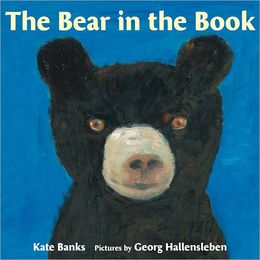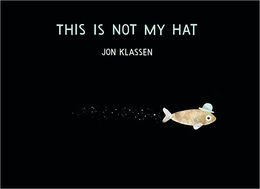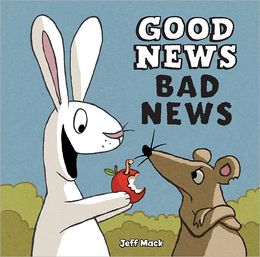A post for grandmas out there: when we go to the bookstore at this time of year to pick out something with no plastic in it, we’re certain to be bombarded with the latest movie-franchise offering or celebrity vanity-stoker. Better books are doubtless tucked away behind the splashy displays, but time is limited and who has enough to park at Barnes & Noble for the afternoon? It might be a good idea to do that anyway (park, I mean), but this post and next Saturday’s might give you a head start. All these books were published in the last six months, which means that if a store doesn’t already have one or more on the shelves, they can get them for you within days. These books all offer a little something extra: a calming influence at bedtime, a moral wallop, a different way of thinking, a stimulation of imagination. Today it’s books for the barely-verbal; next Saturday, intriguing titles for ages 5-8.
The Bear in the Book, by Kate Banks, illustrated by Georg Hallensleben. Farrar Straus Giroux, 2012, 32 pages.

“Once there was a book. It was square, with words, and colorful pictures . . . It belonged to a little boy and it was his favorite book.” At bedtime the boy likes to pull it down from the shelf and hand it to his mama, and if that’s what your little boy or girl likes to do, they’ll enter the experience of the child—and the bear—in the book. As the pages turn, we look over the shoulders of the boy and his mama as they watch a black bear get ready for winter by fattening up and carrying twigs into his den. Winter comes, and “The wind blew its icy breath across the fields. The boy found the animals hidden in the pictures.” Looking, talking, touching, curling up on a soft lap—the story is as much about books as bears. And about children and mamas and the rhythms of days and years. The author and illustrator, who have collaborated on Fox and The Night Worker, make an ideal team. Her simple but elegant prose stands out in bold black letters against his broad, bright brush strokes. If not a perfect bedtime book, it comes close.


The author is a granddaughter of Roger Duvoisin, Caldecott-Award winning author/illustrator of Petunia and other beloved children’s classics. That connection earned this bedtime book a lot of buzz on its publication, as well as prominent displays on bookstore shelves. It’s pleasant and melodic and will probably lull many a drowsy lap-sitter. That said, the poetic images may be over the heads of three-year-olds while the intended audience (4 and up, according to the marketing info) will want more of a story. The title is a question asked by young Jacob while snuggling under the covers and growing progressively sleepier as his mother answers the question with a series of adverbs and similes (sleep comes quietly like a snowfall, silently like a fog, etc.) Soft blue-tinted watercolors accompany the verbal images, all of which are meant to still a small child’s busy day and get her in a quiet state of mind for drifting off. Might work. For wiggly kids, go with Good Night, Good Night, Construction Site.
This is Not My Hat, by John Klassen. Candlewick, 2012, 32 pages. Age/interest level: 2-6.

Parents familiar with John Klassen’s minimalist style already know he has a thing for hats on animals. Last year it was a bear whose favorite chapeau has gone missing under mysterious circumstances. This year we get the same basic story from another point of view. From the opening page, where a little fish swims through dark waters sporting a stylish derby, we know the score: “This hat is not mine. I just stole it.” Through the following pages, delicately tinted with underwater plants and tiny details that speak volumes, we hear his justifications and boasts and follow him into the folly of his perfect crime . . . which turns out to be not so perfect. “Be sure your sins will find you out” never had as clean an exposition, and the additional beauty is that beginning readers can read it themselves.


The many moods of green: forest, sea, lime, pea, fern, and more. The great appeal of this almost-wordless book is not just the thickly-applied oil (or acrylic) colors on canvas, nor the non-linear ways of examining a color (i.e., the “slow” green of an inchworm or “glow” green of fireflies. What really grabs attention are the cutouts on every spread that change perception with the turn of the page. Peas on the right side become tiger eyes when the page is turned to the left. Pebbles transform to moths and moths to flowers; colors shade from “all green” to “never green” (a stop sign!) to green taking a vacation in the winter time. More than clever, it’s also a little mind-bending, as little ones learn without being taught that there’s more than one way to look at a thing.
Good News Bad News, by Jeff Mack. Chronicle, 2012, 32 pages. Age/interest level: 2-5.

The entire text, except for one word, is stated in the title. So what’s left? Lots! This is a picture book whose pictures really do tell the story, a book you can give a two-year-old and let her read to you. Bunny comes knocking on Mouse’s door (well, hole) with a picnic basket: Good news! But then it starts raining, which makes Mouse point out, Bad news. But no—Bunny finds a tree: Good news! The tree is full of apples, one of which hits Mouse on the head: Bad news! But no—they can eat the apples . . . until Mouse gets one with a worm in it, and you get the idea. The situation gets crazier, with the two friends insisting the glass is either half empty or half full, until a crashing climax. Rather thought-provoking for a toddler, and I can see it becoming a household catch-phrase: “Clean up your room!” “Bad news!” “Here’s that puzzle piece you lost—Good news!”
Need more picture-book suggestions? We’ve got ’em! For more Bible-or Christian-based books, see here and here. Or Emily’s list of Bible books for kids from last year. And more books of general interest here (follow the links as well).
Stay Up to Date!
Get the information you need to make wise choices about books for your children and teens.
Our weekly newsletter includes our latest reviews, related links from around the web, a featured book list, book trivia, and more. We never sell your information. You may unsubscribe at any time.
Support our writers and help keep Redeemed Reader ad-free by joining the Redeemed Reader Fellowship.
Stay Up to Date!
Get the information you need to make wise choices about books for your children and teens.
Our weekly newsletter includes our latest reviews, related links from around the web, a featured book list, book trivia, and more. We never sell your information. You may unsubscribe at any time.
FREE Bible Guide!
Get a guide to the Best Bibles for Children and Teens. Perfect for an Easter gift.
We'd love to hear from you!
Our comments are now limited to our members (both Silver and Golden Key). Members, you just need to log in with your normal log-in credentials!
Not a member yet? You can join the Silver Key ($2.99/month) for a free 2-week trial. Cancel at any time. Find out more about membership here.

